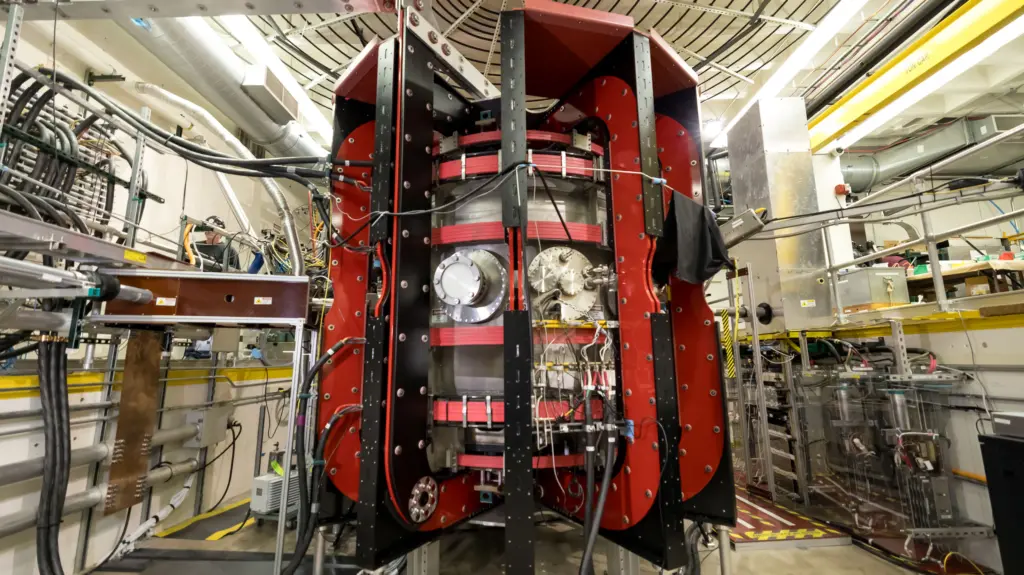After years of work that involved assembling about tens of thousands of components, construction of the new Pegasus-III fusion experiment at the University of Wisconsin-Madison is finished, and researchers have begun experiments that will advance the field of fusion energy.
Supported by the U.S. Department of Energy’s Office of Fusion Energy Sciences, the new Pegasus-III experiment provides a dedicated domestic platform to study innovative techniques for starting a plasma, the ultra-hot ionized gas that releases energy in a fusion reactor.
The ultimate goal of this research is to advance plasma science and understanding of fusion energy to help reduce the cost and complexity of future fusion energy systems, which could potentially provide an abundant source of clean energy by harnessing the process that powers our sun.
“In essence, we’re working to develop an innovative spark plug to light the fusion fire in future fusion energy systems,” says Stephanie Diem, an assistant professor in the Department of Nuclear Engineering and Engineering Physics, who leads Pegasus-III.
The Pegasus-III experiment consists of a compact donut-shaped magnetic bottle, which is called a spherical tokamak, to hold very high-temperature plasmas. Almost every tokamak-style fusion experiment in the world relies on magnetic induction from a central magnet, called a solenoid, to drive the current that creates and heats a plasma.
 UW-Madison researchers are using the new Pegasus-III experiment to study innovative techniques for starting a plasma. Credit: Joel Hallberg.
UW-Madison researchers are using the new Pegasus-III experiment to study innovative techniques for starting a plasma. Credit: Joel Hallberg.
However, eliminating the need for a central solenoid in a tokamak would greatly simplify the construction and reduce the cost of these devices, increasing their viability for commercial energy production. That’s why the UW-Madison researchers are using Pegasus-III to investigate several solenoid-free startup techniques, including local helicity injection, coaxial helicity injection and radiofrequency waves. Local helicity injection is a unique startup method that uses small plasma sources that look like lightsabers to inject ribbons of super-heated plasma, which are captured and confined by a magnetic field. Coaxial helicity injection is a startup method where a voltage is applied between two electrodes to create a bubble of plasma. And radiofrequency wave injection relies on injecting microwaves that are tuned to the natural frequency of charged particles rotating around the magnetic field to transfer energy to the plasma.
“We are in a unique space at UW-Madison where we can study all three of these methods in one device,” Diem says. “Not only can we test each technique independently, but we can also investigate if one technique can enhance another. In addition, we can get our hands on the machine to design whatever experiments we want to test different theories, and this also provides a great hands-on learning opportunity for our students.”
As they learn more about the fundamental plasma physics involved in these startup techniques, the researchers will develop models to scale up to larger fusion devices.
Diem says building Pegasus-III was a massive undertaking and a true team effort. “All that remains of the previous phase of the experiment is the container and a few magnetic coils,” she says. “We’ve built all new power supplies and a new, higher-power toroidal magnetic field to confine the plasma, so this is a brand new facility.”
The construction project began in 2020 as the COVID-19 pandemic was starting, which caused additional challenges. Diem credits the research team’s flexibility, hard work and dedication for the project’s success.
“We have a great and supportive research team, and everyone has been amazing with all the work they put into this,” Diem says. “It wasn’t easy to build a new facility during a pandemic and while also dealing with supply chain issues, so I’m really proud of everyone on the team and very excited that Pegasus-III is running.”
Featured image caption: Assistant Professor Stephanie Diem (left) discusses Pegasus-III fusion research with graduate students Louise Ferris, Carolyn Schaefer and Tim Tierney. Credit: Joel Hallberg.